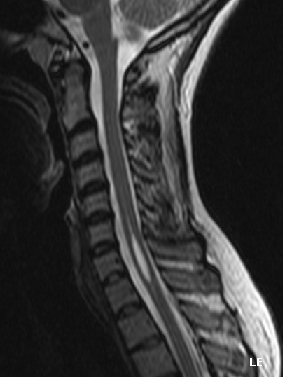Syringomyelia
| Syringomyelia | |
|---|---|
 |
|
| An idiopathic syrinx. See the thin light grey shape inside the spinal cord, placed at centre in the bottom half of the above image. | |
| Classification and external resources | |
| Specialty | Neurosurgery |
| ICD-10 | G95.0, Q06.4 |
| ICD-9-CM | 336.0 742.53 |
| OMIM | 272480 186700 |
| DiseasesDB | 12769 |
| MedlinePlus | 001398 |
| eMedicine | neuro/359 |
| MeSH | D013595 |
Syringomyelia (/sᵻˌrɪŋɡəmaɪˈiːliə, -ɡoʊ-/) is a generic term referring to a disorder in which a cyst or cavity forms within the spinal cord. This cyst, called a syrinx, can expand and elongate over time, destroying the spinal cord. The damage may result in pain, paralysis, weakness, and stiffness in the back, shoulders, and extremities. Syringomyelia may also cause a loss of the ability to feel extremes of hot or cold, especially in the hands. There is also a disorder that generally leads to a cape-like pain (extreme pain, pressure, and many other painful symptoms in the area where a cape would be) and temperature sensation along the back and arms. Each patient experiences a different combination of symptoms. These symptoms typically vary depending on the extent and, often more critically, to the location of the syrinx within the spinal cord.
Syringomyelia has a prevalence estimated at 8.4 cases per 100,000 people, with symptoms usually beginning in young adulthood. Signs of the disorder tend to develop slowly, although sudden onset may occur with coughing, straining, or myelopathy.
Syringomyelia causes a wide variety of neuropathic symptoms due to damage of the spinal cord and the nerves inside. Patients may experience severe chronic pain, abnormal sensations and loss of sensation particularly in the hands. Some patients experience paralysis or paresis temporarily or permanently. A syrinx may also cause disruptions in the parasympathetic and sympathetic nervous systems, leading to abnormal body temperature or sweating, bowel control issues, or other problems. If the syrinx is higher up in the spinal cord or affecting the brainstem as in syringobulbia, vocal cord paralysis, ipsilateral tongue wasting, trigeminal nerve sensory loss, and other signs may occur. Rarely, bladder stones can occur in the onset of weakness in the lower extremities. Classically, syringomyelia spares the dorsal column/medial lemniscus of the spinal cord, leaving pressure, vibration, touch and proprioception intact in the upper extremities. Neuropathic arthropathy, also known as a Charcot joint, can occur, particularly in the shoulders, in patients with syringomyelia. The loss of sensory fibers to the joint is theorized to lead to damage of the joint over time.
...
Wikipedia
